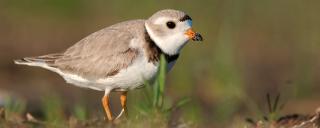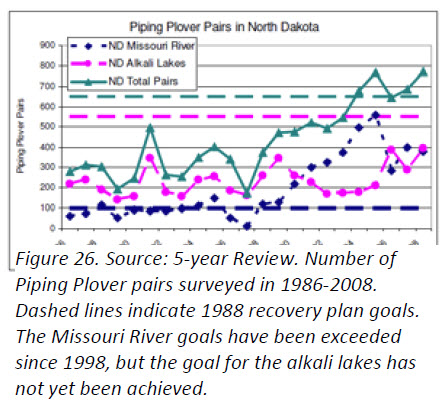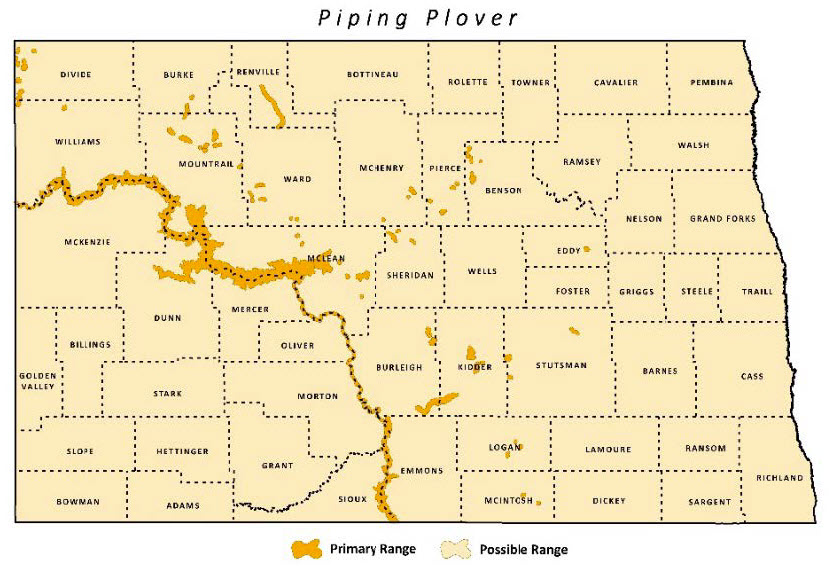
Piping Plover
| Scientific Name | Charadrius melodus circumcinctus |
|---|---|
| General Description | L 7.25”, WS 19”, 1.9 oz. White belly and single, narrow black breast band. |
| Status | Occurs in North Dakota from mid-April to August. Peak breeding season occurs from late May to mid- July. |
| Abundance | Uncommon. |
| Primary Habitat | Sandy or gravelly beaches and sandbars or alkaline wetlands. |
| Federal Status | Migratory Bird, Endangered Species. |
| Reason for Designation | Listed as threatened in 1985. The number of pairs in North Dakota has increased since listing but recovery plan goals have not been met. It is a USFWS Bird of Conservation Concern in Region 6, BCR 11 and 17. Endangered Species Act Listed in Shorebirds of Conservation Concern 2015. |
Locations and Conditions of Key Habitat
Preferred Habitat
Generally characterized as using exposed, sparsely vegetated shores and islands of shallow, alkali lakes and impoundments for breeding. Salt-encrusted, alkali, or sub-saline semi-permanent lakes, ponds, and rivers with wide shorelines of gravel, sand, or pebbles are preferred. Nest in slight hollow in the sand or shoreline, generally near an object such as a clump of grass, rock, or small log but never in heavy vegetation. Forage on fly larvae, beetles, crustaceans, mollusks, and other small animals near the shoreline or sometimes by the nest.
Key Areas and Conditions for Piping Plover in North Dakota
The Alkali Lakes Core Area. Critical Habitat has also been designated by the USFWS. Many plovers also nest on sandbars of the Missouri River.
Problems Which May Affect this Species
Habitat
As a result of channelization, irrigation, and dam construction along the Missouri River, the sandbar habitat for nesting has been drastically altered. Current river flows do not mimic the natural river flows instrumental in forming sandbar habitat. High water releases during peak breeding season may flood nests. Encroachment of woody vegetation onto sandbars reduces nesting habitat availability. A wet cycle in North Dakota, beginning in 1993, has resulted in high water levels on alkali lakes and inundating breeding habitat.
Other Natural or Manmade Factors
Predation by several species of avian and mammalian predators is of concern. Mortality from collisions with power lines and collisions with wind turbines is of increasing concern. Intensifying oil and gas development in North Dakota overlaps with much of the breeding range of Piping Plovers and there is increasing risk of oilfield contamination to alkali lakes and the Missouri River system.
Research and Survey Efforts
Current Research or Surveys
- The U.S. Army Corps of Engineers annually surveys Piping Plovers along the Missouri River system. The program was initiated in 1993. The number of nests, nest success, destroyed nest fate, the number of chicks fledged, and the fledge ratio are calculated.
- The USFWS and The Nature Conservancy monitor Piping Plovers on alkali lakes.
- Northern Prairie Wildlife Research Center is conducting comprehensive surveys and research on various aspects of least tern and Piping Plover habitat, demographics, population dynamics, foraging ecology, and monitoring in the entire Missouri River system.
- The University of North Dakota is using miniature surveillance cameras at least tern and Piping Plover nests to provide information about predators and behavior.
Previous Research or Surveys
- Foraging ecology of Northern Great Plains Piping Plovers, habitat use and reproductive success, breeding density, and breeding success on engineered sandbars are just some examples of studies on Piping Plovers in North Dakota.
- Numerous published reports and gray literature for the species throughout its range. Additional Research or Surveys Needed
- Nothing at this time specific to North Dakota.
Additional Research or Surveys Needed
Nothing at this time specific to North Dakota.
Population and Trend Estimates

- Northern Great Plains Population Estimate: 4,662 individuals
- North Dakota Population Estimate: ~300-400 breeding pairs on Missouri River System and ~200-300 breeding pairs on the alkali lakes.
- Northern Great Plains Recover Plan Goal: 650 breeding pairs; 100 on the Missouri River system and 550 pairs on the alkali lakes. See Figure 26. (Note: at time of SWAP review, the NGP Recovery Plan is also being updated and goals may change or the approach may vary)
Management Recommendations
- Continue to implement the recovery plan.
- Mimic natural flows on the Missouri River to create sandbar habitat.
- The creation of dredged islands or clearing of sandbar vegetation may provide new nesting habitat for plovers, but the productivity is presumed to be much less than for natural sites.
- Use mechanical and chemical applications to remove vegetation.
- If needed, limit human access to sandbars or sensitive areas where plovers are nesting.
- Bury rock piles and remove old buildings to reduce predators.
- Exclusion fences or cages may be erected around nests to reduce nest predation or to exclude cattle.
- Provide alternate sources for cattle to reduce cattle use of shorelines.
- Utility development should follow the guidance of “Reducing Avian Collisions with Power Lines” including marking power lines and creating an Avian Protection Plan.
- Wind industry companies should collaborate with the American Wind and Wildlife Institute for responsible wind development.
Monitoring Plans
Continue to work with the U.S. Army Corps of Engineers and the U.S. Fish and Wildlife Service on long-term monitoring of Piping Plovers along the Missouri River System. Northern Prairie Wildlife Research Center staff have identified a proposed revision of the monitoring program (see Shaffer et al. 2013).
2005-2015 Progress
The Piping Plover remains a Level II Species of Conservation Priority. The 5-year review concludes the Northern Great Plains Piping Plover population remains likely to become endangered, although not in current danger of extinction.

Note: A listing of works consulted when compiling the information on this page may be found in the 2015 State Wildlife Action Plan.
